Exploring the Hanging Gardens of UAE: A Comprehensive Overview
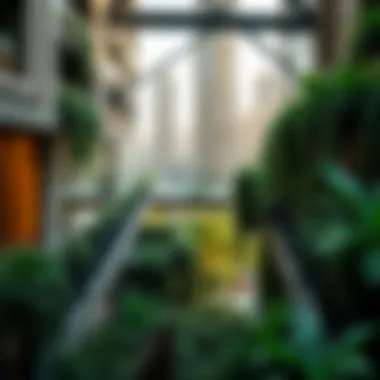

Intro
The concept of urban greenery in a desert landscape has long been a fascinating paradox. In the UAE, particularly in the bustling metropolis of Dubai, this paradox finds expression through the Hanging Gardens, which stand as a testament to innovative design and environmental foresight. As Dubai's skyline flourishes with towering skyscrapers and luxury developments, the integration of lush greenery offers residents an escape from the hectic pace of city life.
This article ventures into the scenic allure of the Hanging Gardens, examining their role in enhancing living spaces, promoting sustainability, and influencing the real estate market. From investment opportunities in these green havens to the plethora of lifestyle features they offer, we’ll unpack how the Hanging Gardens are more than mere decorative landscapes — they are vital components of modern urban living in one of the most ambitious cities in the world.
The following sections will delve into market insights, lifestyle features, and ultimately provide a synthesized view of how these green spaces can redefine the experience of living in a desert setting. As we navigate through this narrative, expect to uncover essential factors that can aid potential homeowners, investors, and expatriates in making informed decisions regarding their lifestyle and investment choices in the UAE.
Intro to the Hanging Gardens
When we talk about the Hanging Gardens of the UAE, it's not just about lush greenery in the desert. These gardens represent a striking blend of nature and urban life, showcasing how innovations in landscaping can transform the harshest environments into bastions of beauty and sustainability. The integration of natural spaces within urban contexts is essential, especially in regions where the climate poses significant challenges.
The significance of these gardens goes beyond mere aesthetics. They serve multiple purposes: contributing to air quality, cooling the local environment, and offering residents and visitors alike a chance to engage with nature in everyday life. This remarkable interaction between urban architecture and landscape is pivotal for investors and homeowners alike, as it adds intrinsic value to properties—a notion that resonates well with today’s eco-conscious buyer.
Historical Context
To fully grasp the Hanging Gardens’ potential, one must understand their roots in the UAE's historical narrative. Despite the harsh desert landscape, the UAE has a rich tradition of falaj irrigation systems, which have been utilized for centuries to cultivate greenery in arid settings. These ancient practices reflect a long-standing desire to harmonize the harsh climate with agricultural endeavors. Revisiting these historical methods sheds light on contemporary designs that prioritize sustainability and resilience.
The gardens echo ancient civilizations' approaches to harmony and beauty. While the legendary Hanging Gardens of Babylon might be lost to history, inspiration from such marvels drives the UAE's architects and environmentalists. By reflecting on historical connections to landscaping, one can appreciate the nuances of modern implementations in the UAE's urban areas.
Concept and Ideation
The concept of the Hanging Gardens is not a mere insertion of foliage into buildings; it's a comprehensive approach to redesigning living spaces. Innovative ideas sprouted from the simple desire to incorporate greenery and biodiversity into residential areas. The notion emerged through collaborations between architects, city planners, and environmentalists aiming to create eco-friendly living spaces.
Take, for instance, the intricate designs that blend natural elements and human-made structures. The gardens often feature terraced landscapes, vertical greens, and water elements crafted to mimic natural ecosystems. This imaginative fusion fosters a serene environment amid busy urban life.
Furthermore, the ideation phase emphasizes creating spaces for community interaction. The gardens aren't just about plant life; they become gathering spots for families, friends, and the community—centers for cultural exchange and social engagement. This multidimensional purpose illustrates that the concept extends far beyond mere aesthetics, offering lifestyle enhancements that align with modern living.
The Hanging Gardens symbolize the synergy of humanity's advancement and nature’s resilience, showcasing what can be achieved when innovation meets tradition.
By delving into historical foundations, exploring conceptual frameworks, and recognizing their potential benefits, we begin to see the Hanging Gardens of the UAE not just as architectural feats but as vital elements of urban living that resonate deeply with cultural values and lifestyles.
Architectural Design Principles
The Architectural Design Principles behind the Hanging Gardens of UAE are crucial in understanding how these green spaces flourish amid the stark desert environment. Integral to the concept is the creative blend of nature and architecture that not only beautifies but also enhances the livability of urban spaces. Facilitating a seamless integration of green areas into bustling urban settings elevates the quality of life for residents and nurtures a stronger community spirit.
Innovative Utilization of Space
In a region where space is at a premium, the innovative utilization of space in the Hanging Gardens cannot be overstated. Green spaces have been designed to maximize vertical and horizontal areas—you see intricate layouts like terraced gardens that stretch skyward. These structures are more than just visual treats; they offer practical benefits. For instance:
- Multi-layered gardens help in air purification, which is a significant consideration in an arid climate.
- Vertical greenery not only beautifies buildings but also acts as insulation, reducing urban heat.
- Efficient water management techniques, such as drip irrigation, promote sustainability without wasting precious resources.
The architecture effectively makes nature re-accessible to inhabitants, where residents can step out to a garden that feels like an oasis right in their backyard. This approach allows the community to engage with their environment in new ways, enhancing social bonds and opportunities for recreation.
Integration with Urban Landscapes
The integration of the Hanging Gardens within the urban fabric of cities like Dubai represents a forward-thinking approach to urban planning. Planners have successfully fused the lushness of nature into the concrete jungle, creating havens of tranquility. Key factors in this integration include:
- Accessibility: Gardens are often located near residential areas, parks, and commercial centers, attracting foot traffic and creating more vibrant public spaces.
- Cognitive and Physical Benefits: Easier access to green spaces encourages outdoor activities, benefiting mental health and well-being. Research has shown that residents living near greenery experience lower stress levels, making it a sought-after feature in modern living.
- Symbiotic Relationship with Infrastructure: The gardens enhance the aesthetic appeal of surrounding buildings while often improving property values. Municipalities understand the importance of having green spaces in their cities, realizing it contributes to overall urban health both environmentally and socially.
The Hanging Gardens of UAE symbolize a leap forward in merging green practices with modern living—making urban planning not just a matter of space but of health, well-being, and community.
Ultimately, the architectural design principles guiding these innovative gardens showcase the importance of sustainable living and highlight how thoughtfully designed spaces can positively impact urban environments. Investing in properties near these gardens means investing in a lifestyle that values nature, community, and future readiness.
Environmental Considerations
The Hanging Gardens of the UAE are not merely a visual treat; they represent a crucial engagement with environmental issues in a region known for its aridity. These gardens illustrate a responsible approach towards ecological sustainability and the preservation of the surrounding environment. With increasing urbanization, understanding the environmental considerations linked to these green spaces is imperative. The emphasis on sustainable practices and their beneficial impacts showcases the transformative potential of integrating nature into urban life.
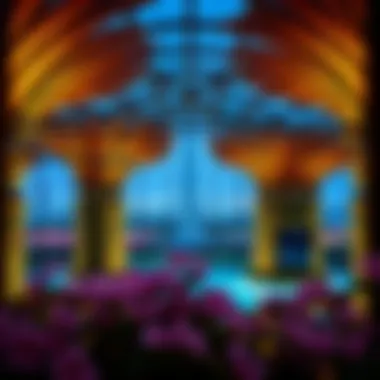
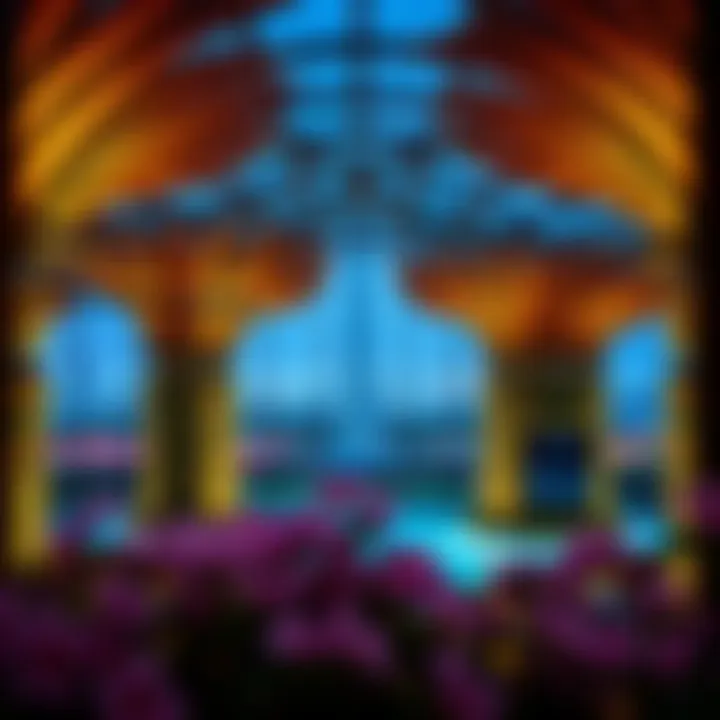
Sustainable Landscaping Practices
Sustainable landscaping is at the heart of the Hanging Gardens’ design ethos. Rather than following conventional methods, these gardens prioritize practices that conserve resources and promote biodiversity.
- Water Conservation: One of the most evident practices involves the intelligent use of water. By incorporating xeriscaping principles, the gardens use drought-resistant plants and efficient irrigation systems, which vastly reduce water consumption. Plants like succulents and native flora thrive in these conditions, requiring minimal watering.
- Soil Health Management: Utilization of organic materials and composting enhances soil health, thus creating a rich environment for plants to flourish. This practice not only supports healthy growth but also reduces dependency on chemical fertilizers.
- Biodiversity Promotion: The gardens are designed to attract a variety of species. By planting a mix of native and compatible species, they foster an ecosystem where flora and fauna can coexist. Polinators like bees and butterflies make these gardens their home, enhancing genetic diversity.
Sustainable landscaping thus serves as a model for future developments in the region. Maintaining an ecosystem that supports wildlife and minimizes human impact stands as a significant commitment to environmental stewardship.
Impact on Local Ecosystems
The development of the Hanging Gardens extends beyond mere aesthetics—it holds profound implications for the local ecosystems. Greener urban spaces can help in reviving and sustaining biodiversity within the deserts of the UAE.
- Climate Regulation: The greenery within these gardens contributes to lowering urban heat. Plants mitigate temperature fluctuations and improve air quality by filtering pollutants. This effect is particularly significant during the sweltering summer months when urban heat islands are prevalent.
- Rainwater Harvesting: The gardens incorporate systems to collect and make use of rainwater. This practice not only aids in irrigating the gardens but also reduces runoff and flood risks within the urban landscape. It reflects a strategic approach to managing water—a precious resource in the region.
- Habitat Creation: The gardens provide a refuge for various species, helping restore habitats that otherwise might have been lost to urban sprawl. Birds, insects, and small mammals benefit from the vegetation, which serves as food sources and nesting grounds.
"Integrating nature into urban environments is no longer a luxury but a necessity that benefits both humans and ecosystems alike."
As demonstrated, the Hanging Gardens not only beautify but also play a crucial role in ecological rehabilitation, fostering a healthier urban habitat. The consideration of environmental factors, alongside an innovative design, brings the gardens closer to achieving a balance between urban expansion and ecological integrity.
For further reading, resources like Wikipedia provide additional insights into sustainable landscaping principles, while studies at Britannica can deepen understanding of local ecosystems.
Cultural Significance
The Hanging Gardens of UAE embody more than just elaborate landscapes; they serve as a powerful symbol of progress and innovation in an arid region. As urban spaces continue to expand, the integration of green areas represents a conscious effort to harmonize nature with modern development. To understand the cultural significance of these gardens, one must consider their ability to convey identity and community values within the context of the UAE's rapid evolution.
Symbolism of Green Spaces
Green spaces are often seen as oases in bustling urban settings. In the context of the UAE, the Hanging Gardens symbolize resilience. They reflect the ingenuity of architects and designers who have transformed an arid environment into a lush canopy of life. The gardens promote the idea that sustainability can thrive in any climate, breaking conventional beliefs about the limitations of green landscapes in desert regions.
Moreover, these spaces serve as communal hubs, inviting residents, expatriates, and tourists alike to gather, explore, and connect. It’s in these gardens where locals celebrate cultural festivities, mark significant occasions, and foster inter-cultural dialogue. This mélange reinforces a sense of belonging, encouraging appreciation for both the natural and built environment.
The concept of reconnecting with Mother Earth may seem universal, but in the context of the UAE, it’s a mantra driving social cohesion. When families stroll through these gardens, it’s not just about enjoying picturesque greenery, but also about passing on traditions, sharing stories, and building connections that span generations.
“In a world where concrete dominates, the Hanging Gardens offer a refreshing reminder of nature’s beauty and necessity.”
Cultural Events and Activities
The Hanging Gardens often serve as backdrops for various cultural events and activities that enrich the community. Musical performances, art exhibitions, and seasonal festivals highlight the diverse traditions and aspirations of the UAE’s residents. For instance, during the annual Dubai Garden Glow festival, spectacular light installations transform these gardens into a mesmerizing spectacle, drawing visitors from all over the globe.
Additionally, community-led activities such as wellness workshops, yoga sessions, and educational initiatives about environmental stewardship promote a healthier lifestyle and foster a proactive approach towards landscape preservation. These activities enliven the gardens, showcasing their dual role as both a natural sanctuary and a vibrant cultural stage.
This focus on active engagement not only enhances the local spirit but also attracts investment interest. Investors and developers recognize the cultural richness associated with such green spaces and their potential to elevate the overall appeal of adjacent properties.
In summary, the cultural significance of the Hanging Gardens in the UAE transcends their aesthetic value. They embody community spirit, sustainability, and creativity, reinforcing the connection between nature and urban living. As the region continues to grow, cultivating these green spaces will be crucial in maintaining the balance between development and cultural heritage.
Lifestyle and Amenities
The exploration of the Hanging Gardens of UAE wouldn't be complete without a detailed look into the lifestyle and amenities they offer. These verdant spaces don't just beautify the skyline; they profoundly enhance the quality of urban living, weaving nature into the fabric of everyday life. Potential residents and investors find these gardens increasingly attractive because they symbolize a blend of luxury and environmental consciousness that is quite rare in such a bustling metropolis.
Living in Proximity to Nature
Living close to nature in urban settings has become a significant selling point for many individuals looking for a home that resonates with their values and lifestyle choices. The Hanging Gardens provide just this. Residents can wake up to the sight of lush greenery and vibrant flowers, a stark contrast to the sterility of concrete landscapes typical of urban environments.
Being surrounded by such greenery offers psychological and physical benefits. Studies show that access to nature reduces stress, lowers anxiety, and improves overall well-being. The gardens provide an oasis for jogging, relaxing, or reading a book while listening to birds chatter—a slice of tranquility amid the city's hustle.
Also, many of these spaces have been designed with walking and biking paths. This encourages residents to lead a more active lifestyle, promoting health benefits that go hand in hand with daily physical activity opportunities. Besides the psychological boosts, the gardens serve a practical purpose, enhancing air quality and temperature regulation around residential areas. This means that not only do residents live side by side with nature, but they also enjoy the tangible benefits it provides.
Community Engagement and Activities
Community remains at the heart of any thriving urban area, and the Hanging Gardens excel in fostering this vital element. By offering shared spaces for gatherings, activities, and events, they create a sense of belonging. Neighbors can easily become friends, cultivating a robust community spirit.
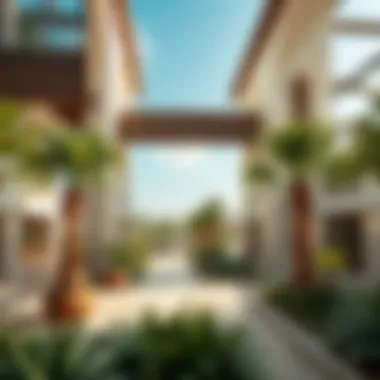
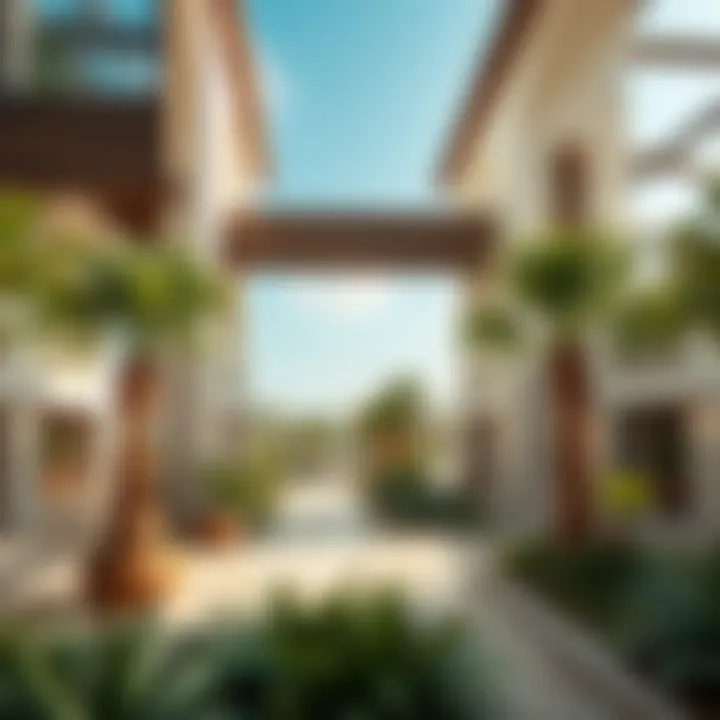
There are often organized events, like outdoor movie nights, gardening workshops, or farmers' markets, that bring people together and encourage participation. For example, the concept of hosting seasonal festivals not only elevates community bond but also highlights local artisans and businesses, thus enriching the local economy.
Additionally, community gardens within these spaces allow residents to grow their own fruits and vegetables. This gives people a chance to engage with one another, share tips, and even trade home-grown produce. Such activities promote sustainability, as they foster an understanding of food sources and healthy living.
In summary, the lifestyle and amenities offered by the Hanging Gardens reflect a shift towards a more integrated urban living experience. They facilitate a connection with nature and the community, enriching quality of life and ultimately contributing to the appeal of this innovative development. City dwellers are not merely looking for a place to live but are seeking a lifestyle that encompasses well-being, community, and nature. This unique combination makes the Hanging Gardens a focus for modern living in the UAE.
Real Estate Implications
The concept of the Hanging Gardens in the UAE extends beyond mere aesthetics; it deeply intertwines with the real estate landscape of one of the world's most dynamic markets. As urban living becomes increasingly prevalent, green spaces are taking on a pivotal role in shaping property value and the overall livability experience within metropolitan areas. This section delves into how these iconic gardens bolster real estate dynamics and influence homeowner and investor decisions alike.
Market Trends and Value Appreciation
In recent years, the integration of unique green spaces like the Hanging Gardens has shown a considerable impact on market trends in Dubai and the broader UAE region. Properties adjacent to these gardens tend to see a surge in interest, impacting their market value significantly. Why, you ask? One reason lies in the attractiveness of blending urban living with nature. Here are some key insights:
- Value Enhancement: Properties near the Hanging Gardens experience a marked increase in value, often appreciating at rates above those in more traditional settings. This appreciation is fueled by the alluring combination of luxury living and access to lush, green landscapes.
- Demand Surge: Buyers, especially expatriates, are increasingly interested in homes that offer not just shelter, but also a healthier lifestyle. The proximity to these gardens often becomes a decisive factor, drawing in potential residents and investors.
- Lifestyle Appeal: Living near the Hanging Gardens means more than just sight; it's also about experiences. Residents benefit from recreational opportunities—like jogging paths or serene spots for relaxation—that promote an outdoor lifestyle, appealing to buyers' emotional connections to nature.
The current trajectory shows a clear trend: as more people recognize the importance of green spaces, properties in close proximity are likely to continue on their upward trajectory of value appreciation.
Investment Opportunities
For investors, the Hanging Gardens represent fertile ground—figuratively-speaking, of course. The following elements delineate how these green spaces can offer lucrative opportunities for savvy investors:
- Commercial Ventures: The rise of the Hanging Gardens acts as a magnet for businesses aiming to cater to residents and tourists alike. Cafés, boutiques, and wellness centers that integrate seamlessly with the garden concept tend to flourish. Investing in commercial property around these gardens not only nurtures the community but also typically yields a higher return.
- Residential Projects: Developers who are keen to tap into emerging trends are recognizing the appeal of residential projects close to these gardens. Such communities may feature modern dwellings that harmoniously blend indoor and outdoor spaces, enticing a market that values sustainability and lifestyle quality.
- Sustainable Investments: As regulations tighten around sustainability, properties that incorporate eco-friendly elements stand to gain favor. The Hanging Gardens embody a commitment to environmental consciousness, making nearby investments more attractive to buyers prioritizing sustainability.
"Green spaces not only beautify urban settings but also enhance property values and foster community connections."
For further insights and updates on real estate trends, you might explore Wikipedia on Urban Green Spaces or visit local market reports at Britannica.
This focus on real estate implications surrounding the Hanging Gardens portrays how essential they’ve become for both residents and investors in the UAE.
Tourism and Economic Impact
The Hanging Gardens of UAE serve as not just a stunning visual spectacle but also a significant cornerstone in understanding the dynamics of tourism and local economies in the region. When discussing tourism's role, one cannot overlook how these verdant spaces create a unique attraction that draws visitors from around the globe. By offering a slice of greenery in an otherwise arid region, they position Dubai as not only a metropolis of glitz but also as a sanctuary for nature lovers.
Attracting Visitors to Dubai
Visitors flock to Dubai each year, eager to experience its unique blend of modern architecture and cultural heritage. The Hanging Gardens contribute directly to this phenomenon by providing a breathtaking contrast to the skyscraper-laden landscape.
Nestled amidst the bustling city, these gardens present a tranquil space for tourists. They invite exploration, relaxation, and a momentary escape from the hectic pace of urban life. The following points elucidate their role in attracting tourists:
- Unique Experience: Unlike other attractions, the gardens boast a harmonious coexistence of nature and urban living, which intrigues many visitors.
- Photo Opportunities: Instagrammable spots abound, allowing tourists to capture memories and share their experiences online, thereby amplifying the allure of the gardens.
- Events and Activities: The gardens often host cultural events, art displays, and wellness activities that appeal to a diverse audience, enhancing their attractiveness.
In essence, the gardens serve as a vital extension of Dubai’s tourism offerings, creating opportunities for visitors to engage with the environment in a unique and memorable way.
Boosting Local Economy
The impact of the Hanging Gardens extends far beyond just aesthetics; they play a critical role in boosting the local economy in several ways.
Promoting economic growth as they draw in tourists, they underpin various sectors, such as hospitality and retail.
Here's how they contribute:
- Increased Foot Traffic: More visitors lead to heightened activity in nearby shops, restaurants, and hotels. Local businesses gain from the bump in clientele, which boosts overall revenues.
- Job Creation: The maintenance, management, and events tied to the gardens create employment opportunities within the community. This includes everything from horticulturists to event coordinators.
- Real Estate Value: Properties near these green spaces often see a rise in value, attracting investors who recognize the demand for living close to nature. Higher property values translate to increased tax revenues for local governments, which can be used to fund public services.
"The Hanging Gardens are a catalyst for economic vitality, embodying the potential for urban nature to inspire sustainable growth."
In summary, the connection between the Hanging Gardens and tourism in Dubai is profound, enhancing both visitor experiences and local economic prospects. The gardens embody more than just beautiful landscapes; they represent a new way of approaching urban development that prioritizes sustainability and community involvement.
Challenges and Considerations
The development of the Hanging Gardens in the UAE is a remarkable feat but not without its share of challenges. Addressing these challenges is essential for ensuring the success and sustainability of these innovative green spaces. Engaging with nature in urban environments has a multitude of benefits, including improving air quality and promoting mental well-being. However, the unique elements of these hanging gardens necessitate careful consideration to balance aesthetics with practicalities.
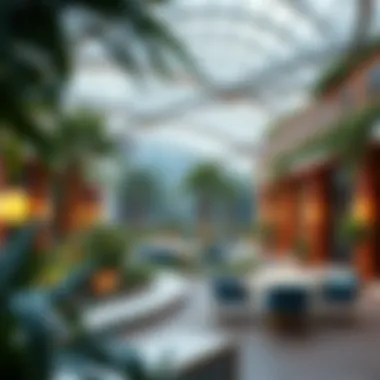

Maintenance and Sustainability
Maintaining the elegance and functionality of the Hanging Gardens requires ongoing attention, resources, and innovative strategies. The arid climate of the UAE presents unique concerns, notably regarding water management. Strategies such as drip irrigation systems minimize water waste and ensure that plants receive the necessary moisture without saturating the soil, which could lead to erosion or plant stress.
Furthermore, choosing native and drought-resistant plants plays a pivotal role in sustainability. These plants are often more resilient to the harsh conditions of the desert and require less maintenance, which can significantly reduce long-term costs for homeowners and community developers. The concept of xeriscaping is particularly valuable here, as it emphasizes landscaping that conserves water while promoting biodiversity.
Additionally, regular maintenance routines are crucial. Integrated pest management techniques can help keep gardens healthy without resorting to harmful chemicals, while periodic assessments of soil health ensure that nutrients are continuously available to plants. Thus, planning for holistic maintenance efforts not only helps in preserving garden aesthetics but also firmly anchors sustainability within the development.
Navigating Regulatory Frameworks
Steering through the regulatory environment surrounding the Hanging Gardens presents its own set of complexities. The UAE government has established various guidelines aimed at ensuring projects are environmentally sound and socially beneficial. For developers, understanding these regulations is vital to prevent legal issues that could delay or halt projects.
Building codes, zoning laws, and environmental impact assessments are part of the landscape of compliance that must be actively managed. Engaging with local authorities early in the planning process can smooth the path for developers. Collaboration with environmental agencies not only aids in meeting regulatory requirements but also opens doors to opportunities for grants or funding tailored towards sustainable projects.
Moreover, public sentiment surrounding the Hanging Gardens is important. Community input and support can make or break a project, and local residents often have valuable insights that can enhance design and functionality. Being transparent about intentions and actively involving the community fosters goodwill and results in a more successful integration of the gardens into the urban fabric of Dubai. In this way, navigating regulatory frameworks transforms from a hurdle into a collaborative opportunity, paving the way for experiences that genuinely enrich urban living.
Future of Hanging Gardens in UAE
The future of the Hanging Gardens in the UAE not only encompasses its continuing development but also the ongoing significance that these spaces will hold in urban settings. As cities grow and evolve, their capacity to integrate nature with urban living becomes ever more crucial. This topic provides a lens through which we can examine the commitment to sustainable urban ecosystems and the innovative solutions that propel city design into a greener future. The gardens represent a shift towards valuing biodiversity and improving the quality of life for residents and visitors alike.
Innovations in Landscape Architecture
As we look ahead, innovations in landscape architecture are set to redefine the way urban spaces are designed. For the Hanging Gardens, this means incorporating advanced technologies and sustainable design principles that enhance both aesthetics and functionality. From water-efficient irrigation systems to smart gardens that utilize sensor technology, the potential for creating self-sustaining green spaces is abundant.
Some upcoming innovations include:
- Modular Planting Systems: These allow for versatile planting options that can adapt to climate fluctuations, making it easier to maintain the gardens.
- Vertical Gardens: This technique optimizes the use of space since they can easily be installed on walls and other structures, thus expanding the greenery without consuming valuable ground area.
- Native Plant Landscaping: By utilizing plants that are naturally adapted to the region's climate, landscape architects can ensure lower maintenance and better water conservation.
These advances not only beautify urban environments but also serve practical purposes, such as improving air quality and providing habitats for local wildlife. Such strides in landscape architecture demonstrate a commitment to weaving nature into the urban fabric, ensuring a balanced coexistence between humans and their environment.
Vision for Growth and Expansion
The vision for the growth and expansion of the Hanging Gardens in the UAE goes beyond mere physical architectures; it reflects a reimagination of urban living. Urban planners are increasingly focusing on how these green spaces can be interconnected, creating a network of parks and gardens that encourages residents to engage with nature regularly.
Key aspects of this vision include:
- Community Connectivity: Future expansion will aim to connect the Hanging Gardens with other parks and community spaces, providing a seamless transition for residents.
- Cultural Integration: Incorporating art and cultural elements into the gardens can enhance their significance as recreational spaces that celebrate local heritage.
- Educational Initiatives: Future projects may also include educational facilities that emphasize environmental awareness and sustainable practices, teaching generations the importance of nature conservation.
Growth will no longer focus solely on aesthetics or real estate value but will value the contributions these gardens make to wellbeing and community cohesion. As urban areas continue to expand, the importance of integrating these green spaces into the daily lives of residents cannot be overstated.
The future of urban living lies in the harmony between nature and the built environment. The Hanging Gardens symbolize this shift and encourage a broader dialogue about how we engage with greenery in our cities.
As the UAE forges ahead, the Hanging Gardens are poised to become not only a hallmark of architectural beauty but also a catalyst for sustainable urban practices that benefit both people and the planet.
Ending
The Hanging Gardens of UAE are more than just a lush retreat from the surrounding aridity; they symbolize the successful fusion of nature and modern lifestyle within an urban setting. As cities globally grapple with the challenges of sustainable development, these gardens emerge as exemplars of how to harmonize environmental mindfulnes with growing urban needs.
Recap of Key Insights
Throughout this article, we explored several significant aspects of the Hanging Gardens. First, we examined their historical context, revealing a vision that balances traditional Emirati values with contemporary architectural principles. This concept employs innovative utilization of space, ensuring that gardens coexist seamlessly with the urban landscape. The environmental considerations highlighted show the gardens not only as aesthetic enhancements but also as havens for local wildlife, which underscores the impact on local ecosystems.
Additionally, the cultural significance of these gardens came to light, showing their role as communal spaces which host a variety of cultural events and activities. For investors and homeowners, the implications on real estate were explored, illustrating how these green spaces can drive market trends and provide compelling investment opportunities.
The challenges of maintaining these environments while navigating regulatory frameworks also cannot be overlooked, making it clear that ongoing commitment is required for success. Looking ahead, the future of Hanging Gardens in the UAE appears promising with innovations in landscape architecture that will likely push boundaries further.
Final Thoughts on Integration of Nature and Urban Life
By blending leisure with environmental consciousness, the Hanging Gardens become a vital piece of the urban puzzle, offering a blueprint for future developments. The ongoing dialogue about sustainability encourages community engagement, driving home the point that we all share responsibility for our environment. The success of this project sets a benchmark that might influence other regions to adopt similar initiatives, thus redefining urban living for generations to come.
"Green spaces are not a luxury, but a necessity for fostering community and biodiversity in urban settings."
Sources:
- Wikipedia on Urban Gardens
- Britannica on Landscape Architecture
- UAE Government
- Local Real Estate Trends















